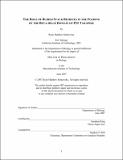The role of buried stack residues in the folding of the beta-helix domain of P22 tailspike
Author(s)
Simkovsky, Ryan Matthew
DownloadFull printable version (25.75Mb)
Other Contributors
Massachusetts Institute of Technology. Dept. of Biology.
Advisor
Jonathan King.
Terms of use
Metadata
Show full item recordAbstract
In-register, parallel alignment of similar or identical side chains is a common structural phenomenon in amyloid fibers. In the crystal structure of an amyloid fiber, these residues not only align, but take identical side chain orientations, creating long stacks of identical residues with identical orientations. This phenomenon of side chain stacking is a dominant component of the amyloid structure, and may take an equally important role in the seemingly sequence-independent formation of amyloid fibers or the sequence-dependent species barrier to amyloid transmission. Side chain stacking has long been observed as a prominent feature of the soluble parallel [beta]-helix fold, which exhibits a cross-[beta] structure reminiscent of amyloids. To investigate the sequence requirements of these stacks for directing a polypeptide chain into a [beta]-helical fold, we performed systematic mutational studies using the complete P22 tailspike protein, which contains a 13 rung [beta]-helix domain. The in vivo folding and assembly of 150 single mutant polypeptide chains were characterized at multiple temperatures by SDS-PAGE, which distinguishes the fully native, SDS-resistant state from partially folded or misfolded conformers. The vast majority of the buried core was completely intolerant to substitution at physiological temperatures, while only a few sites composing a continuously contacting network of residues called the folding spine were intolerant of alanine mutations at 18⁰C. These results indicate that the [beta]-helix folds through a processive folding mechanism, analogous to the nucleation and elongation mechanism of amyloids, but requiring recurring sequence-dependent stacking contacts that stretch the length of the [beta]-helix. Numerous avenues of investigation demonstrated that the observed folding defects of the full length tailspike were due to a sequence effect on the folding of the [beta]-helix domain. (cont.) Alanine mutants capable of reaching a native-like trimeric state were as thermostable as the wild-type trimer, indicating that mutants affect a folding intermediate rather than the native state. In vivo folding efficiencies of eight [beta]-helix folding mutants in the context of the isolated [beta]-helix domain paralleled the folding of the full length tailspike, demonstrating that these mutants act at the level of [beta]-helix folding. In vitro refolding of both full length and isolated [beta]-helix tailspike mutants demonstrated that the observed mutant folding deficiencies were solely caused by the single amino acid change and not due to interactions with cellular components. Folding spine mutations were further tested in the context of a suppressor mutation, A334V, which was previously shown to stabilize the [beta]-helix and rescue classic temperature sensitive folding mutations. Most mutations could not be rescued by the addition of A334V, a number of which were in fact further hindered in folding by the presence of the suppressor mutation. Eight folding spine mutations located between rungs 4 and 6 were rescued in a position specific manner, though only one of these positions directly contacts the suppressor. The pattern of rescue and hindrance observed with double mutants indicates that A334V is not a global suppressor and instead acts on a likely nucleus for folding. These studies provide evidence for a nucleation and elongation mechanism for folding of the parallel [beta]-helix. Single mutations throughout the [beta]-helix are capable of blocking this step-wise folding mechanism in a temperature dependent manner that likely leads to the population of a partially folded [beta]-helix species that would be inherently aggregation prone.
Description
Thesis (Ph. D.)--Massachusetts Institute of Technology, Dept. of Biology, 2007. This electronic version was submitted by the student author. The certified thesis is available in the Institute Archives and Special Collections. Includes bibliographical references (p. 170-188).
Date issued
2007Department
Massachusetts Institute of Technology. Department of BiologyPublisher
Massachusetts Institute of Technology
Keywords
Biology.